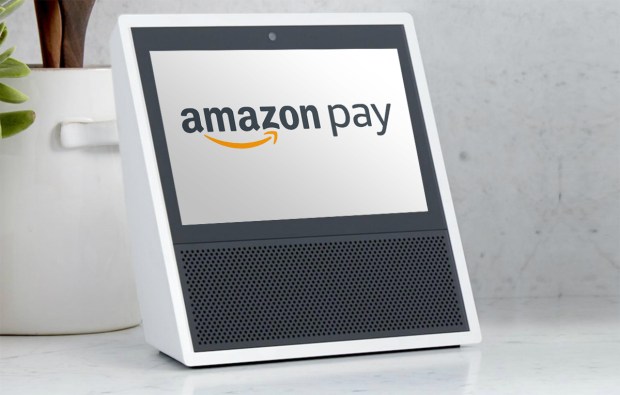Alexa: From Voice To A Conversation About Commerce

Dan, like many millions of Americans this time of the year, is traveling for the holidays.
Three weeks ago, he logged onto his favorite airline bookings site and snagged a [pricey] round-trip plane ticket from San Francisco to Saginaw, Michigan to see his family.
If Dan is like most consumers, he probably did this using a device that had a screen – either his desktop or his mobile – since travel planning involves a lot of factors and decisions on the path to purchase, from dates and destination to prices and seat selection.
Thursday morning, Dan packs his bags. His assistant reminds him to bring at least one wool sweater and boots, because although San Francisco is mild and sunny, Saginaw will be getting snow – and it’s plenty cold.
As Dan’s trying to cram the down coat into the suitcase, his assistant checks the local traffic conditions and orders a car service so he’ll make it to the airport in time. While in the car, she reminds him to call the client his firm just closed to answer a quick question before the holiday. She also lets him know that all but one of the gifts he ordered online made it safely to his folks’ home, and offers a few suggestions on what could be ordered to arrive in time for Christmas morning.
At the airport, Dan’s assistant asks if he’d like to upgrade his seat, enjoy a meal during the trip or access the in-flight Wi-Fi now that he has work to do, then ensures that these services are purchased for him before he gets onboard. She also asks whether Dan would like to have an Uber waiting at the airport in Michigan when he lands, and arrange for it to stop by the bakery on the way home to pick up his mother’s favorite lemon/blueberry breakfast bread as a surprise for her when he gets there.
These are all the “day-of” decisions that go into the complete travel experience.
Dan didn’t know when he booked a few weeks back whether he would want to work on his laptop during the flight or kick back and read a book. He didn’t know how hungry he would be or whether a snowstorm was predicted to dump two feet of powder on his parents’ house on Christmas Day. He didn’t know there would be an accident holding up traffic on the 101, which could have made him miss his flight.
Dan’s purchase journey certainly wasn’t over the day he bought his plane ticket – and in some ways, it was just beginning. But like most busy people getting ready to leave town for the holidays, he wasn’t thinking about all of the residual things that could have created tons of friction for him, as he didn’t have the bandwidth to sit and think about it all before heading to the airport. And in those last couple of hours of frantic packing and trying to leave the house, chances are he wasn’t looking at his phone waiting to be presented with prompts that might have triggered further thoughts.
That’s why Dan is so psyched that he had his assistant take care of it all.
His voice-activated virtual assistant, that is.
Everyman’s Assistant
Dan (or any hypothetical consumer) need only say the word for it to happen – literally.
Today, with voice-activated technology reaching new heights, it’s possible for any Average Jane or Dan to have an assistant of their own to remove the friction associated with typical day-to-day experiences, like the mad holiday dash to get the airport with all of the details handled and managed.
On the heels of the announcement that Amazon Pay is now being integrated with Alexa skills, Amazon Pay’s VP and GM, Patrick Gauthier, told Karen Webster that experiences like the hypothetical Dan’s and Jane’s are well within the realm of possibility.
But only if the voice-activated assistant can use context to anticipate what those everyday users might need or want to do, and then offer helpful suggestions on how to get those things done.
Just like any good human assistant would do.
“Take ‘Dan’ and his trip home for the holidays,” Gauthier posited. “Unless a voice assistant can be proactive and contextual and anticipate Dan’s needs, it just adds more friction for Dan, since he has to remember, then ask, then explain the context to a piece of technology that may still get it wrong.”
Voice, Gauthier said, provides a more complete, natural and delightful experience for the customer. When enriched by data, AI, context and a seamless integration with payments, voice becomes a platform for merchants to offer more services in a way that adds value to the customer and, ultimately, more sales to merchants.
That’s Amazon vision for Alexa.
Alexa, Gauthier said, was created to be more than just an interface. It’s an experience that provides her users with access to a range of services – now 25,000 skills strong – that make their lives easier.
People who have Alexa call her “she,” not “it,” and people who want to buy the devices through which they access Alexa don’t ask for an Echo or an Echo Show – they ask for Alexa, Gauthier remarked. Alexa is the friendly, helpful, virtual – and personal – face of the portfolio of connected devices sold in stores and online. Gauthier believes that’s why customers love Alexa in a way they will never love their smartphones or the keyboards on their desktops or laptops.
The Power Of Voice … With Context
The evolution of Alexa over the last several years has been as much about the technology that has fueled the growth of its ecosystem – which now includes more than 25,000 skills and a portfolio of connected endpoints, including cars – as it has been about evolving the experience that she enables for her users.
Gauthier believes that voice is the most intuitive method of interface for a consumer engaging with commerce, and one that can serve as both an entry point and a destination. Sometimes, people browse on their mobile devices before heading to the desktop to purchase high-consideration items, Gauthier said. Or they may take their learnings from mobile into a brick-and-mortar venue, or vice versa if they are hunting for that dress they tried on but didn’t buy at the store.
In either case, voice can be a complement to that commerce experience – asking Alexa where to go to try on and then buy that dress in her size to save time, or to ask Alexa to buy it from the retailer she just left after deliberating and deciding it was perfect after all. Or asking Alexa to show her the demo of the Nikon D3300 on her Echo Show before she forks over the $396 to buy it for her husband for Christmas.
But not all commerce opportunities are necessarily about buying something from a store and not all voice experiences are related to commerce. Gauthier said that he sees great use cases emerging for voice and Alexa as an enabler to customer service and search that help connect a person with a personal services provider.
Take tutoring, for example.
Imagine Alexa with a screen helping students sharpen their math and science and language skills – both using voice and visual, Gauthier said – while also suggesting study aids and related books to purchase, as well using Alexa and Amazon Pay to make it frictionless.

Voice Is To Mobile As Mobile Is to Web
For the amount of potential that lies in the combination of voice and commerce, Gauthier cautioned against thinking of voice as simply a different interface to do the things that can be done today on mobile. Although the technologies can accomplish many of the same things, if innovators limit themselves to thinking about how to replace mobile with a new form factor called voice that performs all the same tasks, they will have failed.
Success means reimagining the set of activities that humans do today, using voice to bring it to life.
When web and eCommerce emerged as an interface for the internet, consumers were presented with infinite inventory and near-infinite information, said Gauthier. People shopped online because it gave them more choices and more information about those choices, including product comparisons and reviews, in a much more efficient fashion. The value to the consumer lied in the ability to sit in front of a computer to collect and compare that same information, instead of getting in the car and driving to multiple stores.
Mobile cut the tether to a physical location, which was a requirement for the web interface before it, and blended the online and offline worlds. Searching the World Wide Web on a desktop computer was bound to a place – the office or the family room at home – while mobile let users do all of the same things, wherever they and their devices happen to be.
Now, as voice carves out its own niche, the developmental arc is complete, Gauthier said. Mobile enables anywhere activity, but still ties the user to a single device. Voice, on the other hand, can be used on many devices, including mobile.
Voice is instant, conversational and efficient, Gauthier said. There’s no fishing out a device to open an app. Just speak – and your wish, from Amazon’s standpoint, is Alexa’s command.
According to Gauthier, that in itself unlocks so many new doors that it would simply be redundant to spend too much time or investment on applying this new technology to problems that mobile has already solved.
Voice can also be safer, Gauthier noted, since it’s far less risky for a consumer to talk to her car and tell Alexa to order and pay ahead at Dunkin’s to get their $0.87 coffee every Monday rather than fumbling with the touchscreen on a mobile phone while driving or in between red lights.
“If we try to reproduce with voice what has been working with mobile, it will be a lost opportunity,” Gauthier said. “I am absolutely positive that the introduction of voice as an interface and the frictionless embedding of Amazon Pay will open up new commerce use cases.”
Those new use cases, he suggested, are what developers and innovators should be chasing – and vigorously.
Gauthier said that voice is the start of a conversation, but only the start. Alexa’s ambition is to move voice – and today’s voice assistants – from a linear ask to a conversation, and then from a conversation to human-like interactions.
It’s an opportunity that he believes are both possible and limitless – and for one reason.
“There’s no limit to the type of conversations that humans can have,” said Gauthier. “One reason we’re doing the Voice Challenge with PYMNTS is to tap into the imagination of the crowd – and inspire the as yet unimagined creativity that conversations about commerce can unlock.”
 If you’ve got some creative ideas about how to turn voice into a new conversation about commerce and would like to participate in the PYMNTS Voice Challenge with Alexa, please click here. A limited number of teams will have the opportunity to access beta versions of the new Alexa/Amazon Pay SDKs, and will be mentored individually by the Amazon Pay and Alexa teams.
If you’ve got some creative ideas about how to turn voice into a new conversation about commerce and would like to participate in the PYMNTS Voice Challenge with Alexa, please click here. A limited number of teams will have the opportunity to access beta versions of the new Alexa/Amazon Pay SDKs, and will be mentored individually by the Amazon Pay and Alexa teams.